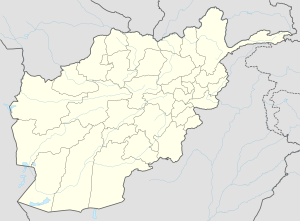Bamiyan
|
Bamyan بامیان |
|||||||||
|---|---|---|---|---|---|---|---|---|---|
|
|||||||||
| Location in Afghanistan | |||||||||
| Coordinates: 34°49′N 67°49′E / 34.817°N 67.817°ECoordinates: 34°49′N 67°49′E / 34.817°N 67.817°E | |||||||||
| Country |
|
||||||||
| Province | Bamyan Province | ||||||||
| Settled | 1800 BCE | ||||||||
| Government | |||||||||
| • President of City Council | Habiba Sarabi | ||||||||
| Area | |||||||||
| • Total | 35 km2 (14 sq mi) | ||||||||
| Elevation | 2,550 m (8,370 ft) | ||||||||
| Population (2014) | |||||||||
| • Total | 100,000 | ||||||||
| Time zone | UTC+4:30 | ||||||||
Bamyan (Persian: بامیان Bāmyān), also spelled Bamiyan and Bamian, is the capital of Bamyan Province in central Afghanistan. With an altitude of about 2,550 m and with a population of about 61,863, Bamyan is the largest town in the central Afghan region of Hazarajat, and lies approximately 240 kilometres north-west of Kabul, the national capital. Bamyan was the site of an early Hindu–Buddhist monastery from which Bamyan takes its name (Sanskrit varmayana, "coloured"). Bamyan's name is translated as ‘The Place of Shining Light’. Many statues of Buddha are carved into the sides of cliffs facing Bamyan city. In 2008, Bamyan was found to be the home of the world's oldest oil paintings. The city of Bamyan has a population of 100,000 (in 2014). it has four districts and a total land area of 3,539 hectares. The total number of dwellings in this city are 4,435.
The Bamiyan valley marked the most westerly point of Buddhist expansion and was a crucial hub of trade for much of the second millennium CE. It was a place where East met West and its archaeology reveals a blend of Greek, Turkish, Persian, Chinese and Indian influence.
Situated on the ancient Silk Route, the town was at the crossroads between the East and West when all trade between China and the Middle East passed through it. The Hunas made it their capital in the 5th century. Because of the cliff of the Buddhas, the ruins of the Monk's caves, Shar-i-Gholghola ('City of Sighs', the ruins of an ancient city destroyed by Genghis Khan during the 1221 siege of Bamiyan), and its local scenery, it is one of the most visited places in Afghanistan. The Shar-i-Zohak mound ten miles south of the valley is the site of a citadel that guarded the city, and the ruins of an acropolis could be found there as recently as the 1990s.
...
Wikipedia








